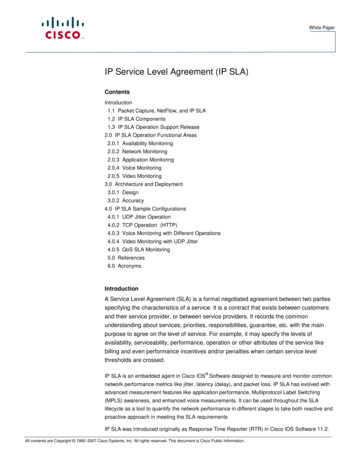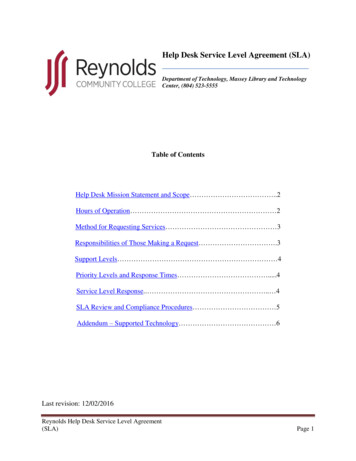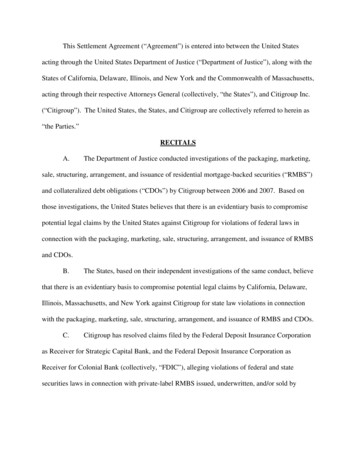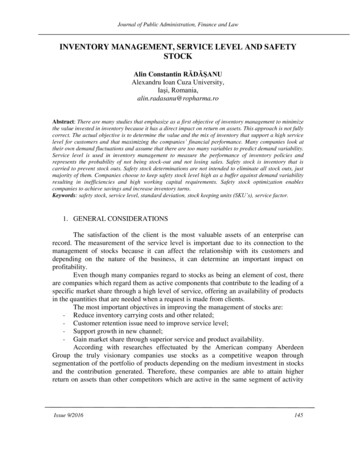
Transcription
White PaperIP Service Level Agreement (IP SLA)ContentsIntroduction1.1 Packet Capture, NetFlow, and IP SLA1.2 IP SLA Components1.3 IP SLA Operation Support Release2.0 IP SLA Operation Functional Areas2.0.1 Availability Monitoring2.0.2 Network Monitoring2.0.3 Application Monitoring2.0.4 Voice Monitoring2.0.5 Video Monitoring3.0 Architecture and Deployment3.0.1 Design3.0.2 Accuracy4.0 IP SLA Sample Configurations4.0.1 UDP Jitter Operation4.0.2 TCP Operation (HTTP)4.0.3 Voice Monitoring with Different Operations4.0.4 Video Monitoring with UDP Jitter4.0.5 QoS SLA Monitoring5.0 References6.0 AcronymsIntroductionA Service Level Agreement (SLA) is a formal negotiated agreement between two partiesspecifying the characteristics of a service. It is a contract that exists between customersand their service provider, or between service providers. It records the commonunderstanding about services, priorities, responsibilities, guarantee, etc. with the mainpurpose to agree on the level of service. For example, it may specify the levels ofavailability, serviceability, performance, operation or other attributes of the service likebilling and even performance incentives and/or penalties when certain service levelthresholds are crossed. IP SLA is an embedded agent in Cisco IOS Software designed to measure and monitor commonnetwork performance metrics like jitter, latency (delay), and packet loss. IP SLA has evolved withadvanced measurement features like application performance, Multiprotocol Label Switching(MPLS) awareness, and enhanced voice measurements. It can be used throughout the SLAlifecycle as a tool to quantify the network performance in different stages to take both reactive andproactive approach in meeting the SLA requirementsIP SLA was introduced originally as Response Time Reporter (RTR) in Cisco IOS Software 11.2.All contents are Copyright 1992–2007 Cisco Systems, Inc. All rights reserved. This document is Cisco Public Information.
White PaperRTR was renamed Service Assurance Agent (SAA) in 12.0(5)T. Version 12.3(14)T introduced themore aptly named term, IP SLA. All the corresponding command-line interface (CLI) operationsnow reflect this name in both show and configuration commands. During the name change, thecore IP SLA code in Cisco IOS Software also changed from the older code, known as IP SLAEngine 1, into the newer code, known as IP SLA Engine 2. Figure 1 shows the name transition andthe corresponding changes in the Cisco IOS Software CLI to reflect it.Figure 1.Name Changes1.1 Packet Capture, NetFlow, and IP SLAIP SLA operations are sometime referred to as probes, not to be confused with hardware orsoftware packet-capture applications like tcpdump or ethereal or hardware-based sniffers, whichare also referred to as probes. Packet capture works in a promiscuous mode; that is, packet capture applications actively listen and capture packets in the wire. NetFlow is a Cisco technologythat allows Cisco devices to send packet flows to a NetFlow collector application. Both packetcapture and NetFlow collectors are passive probes; they capture the actual network traffic flows tobase their analysis. IP SLA operations are based on active probes; synthetic network traffic isgenerated strictly for the purpose of measuring a network performance characteristic of the definedoperation. By using an active probe mechanism with synthetic network traffic, IP SLA has greaterflexibility: It has visibility of the processing time on the device versus transit or on-the-wire time and,therefore, can give a more granular and accurate measurement. It can differentiate among different measurements, for example, User Datagram Protocol(UDP) versus Internet Control Message Protocol (ICMP) or TCP statistics, so themeasurement specifically reflects the current operation and not a generalized overview ofthe entire traffic. IP SLA can be used as a proactive tool since it allows traffic to be created in a controlledenvironment using different protocols and ports. This allows greater flexibility in terms ofsimulating future growth with expected traffic patterns or creating a baseline with existingbenchmarks.Because of their distinct areas of operation and architecture, IP SLA and NetFlow technologiescomplement each other; IP SLA is more suited for performance measurement, whereas NetFlow ismore geared toward accounting. Some other advantages of using IP SLA are: Near millisecond precision Proactive notification using Simple Network Management Protocol (SNMP) traps based ona defined threshold or trigger of another IP SLA operation Historical data storage Comprehensive hardware support makes this a very cost-scalable solution because it doesnot require dedicated probesAll contents are Copyright 1992–2007 Cisco Systems, Inc. All rights reserved. This document is Cisco Public Information.Page 2 of 19
White Paper1.2 IP SLA ComponentsIP SLA has two main components (Figure 2):Figure 2.Components of IP SLASource This Source is where IP SLA operations are defined. Based on the configurationparameters, the source generates packets specific to the defined IP SLA operations andanalyzes the results and records it so that it can be accessed through CLI or SNMP. Asource router can be any Cisco router that can support the IP SLA operation beingconfigured.Target The IP SLA target depends upon the type of IP SLA operation defined. For FTP/HTTPoperations, the target would be an FTP/HTTP server. For Routing Table Protocol (RTP) andUDP jitter (voice over IP [VoIP]), the target must be a Cisco device with the responderfeature enabled, since both the source and target participate in the performancemeasurement. The IP SLA responder has an added benefit of accuracy because it insertsin/out time-stamps in the packet payload and therefore measures the CPU time spent. TheIP SLA responder can be enabled with the configuration command:ip sla responder1.3 IP SLA Operation Support ReleaseTable 1 maps IP SLA operations with each supported Cisco IOS Software version.Table 1.FeatureIP SLA Operations and Cisco IOS Software .4(4)TICMP Echo ICMP EchoPath UDP Echo TCPConnect UDP Jitter HTTP All contents are Copyright 1992–2007 Cisco Systems, Inc. All rights reserved. This document is Cisco Public Information.Page 3 of 19
White PaperDNS DHCP DLSW SNMPSupport UDP JitterWithOne WayLatency FTP Get MPLS/VPNAware FrameRelay (CLI) ICMP PathJitter APM Voice withMOS/ICPIFScore Post DialDelayH323/SIPVoice withRTP The various IP SLA operations can also be classified as follows: ICMP-based operations for echo, path echo, and path jitter UDP-based operations, such as echo, jitter, Domain Name Service (DNS), and DynamicHost Configuration Protocol (DHCP) TCP-based operations, such as TCP connect, FTP, HTTP, and DLSw Layer 2 operations, such as Frame Relay, ATM, and MPLS VoIP-related operations, such as VoIP jitter, VoIP gatekeeper registration delay monitoringand VoIP call setup (postdial delay) monitoring. The new RTP-based VoIP operation wasintroduced in Cisco IOS Software Release 12.4(4)T.2.0 IP SLA Operation Functional AreasIP SLA operations can be broadly categorized into the functional areas availability monitoring,network monitoring, application monitoring, voice monitoring, and video monitoring.2.0.1 Availability MonitoringICMP EchoICMP echo measures the end-to-end response time between a Cisco router and any IP device bymeasuring the time between sending an ICMP echo request message to the destination andreceiving an ICMP echo reply. This operation takes into account the processing time taken by thesender but cannot take into account any processing time in the target device. This is a good tool tomeasure availability but does not give much indication if there are any underlying problems in thenetwork or destination host.ICMP Path EchoThe path discovered ICMP echo operation is different from the regular ICMP echo in that it firstdoes a traceroute to discover the path from a source to the destination and then measures theAll contents are Copyright 1992–2007 Cisco Systems, Inc. All rights reserved. This document is Cisco Public Information.Page 4 of 19
White Paperresponse time between the source router and each of the intermittent hops in the path. It also hasan option of using strict and loose source routing (LSR), which enables IP SLA to use a particularpath instead of using traceroute’s discovered path. This operation gives more detail on the IPaddresses of the hops taken as well as any failures in the intermediate path.ICMP JitterThe ICMP jitter operation is very similar to ICMP echo but also provides latency, jitter, and packetloss beside the round-trip measurement. Jitter, also known as IP Packet Delay Variation (IPDV), isa measurement of delay variation. For example, if five packets are sent with an interval of 5 mseach, they should be received 5 ms apart at the destination. If a certain packet arrives after 7 ms,the jitter value is a positive number 2 (7 – 5); if it is received in 3 ms, the value is a negative jitter of–2 (3 – 5). For applications like VoIP and video, a jitter value of 0 is the most ideal.ICMP Path JitterThe path discovered ICMP jitter operation is very similar to ICMP path echo but also provides jitteroperation statistics like latency, jitter, and packet loss on a per hop basis. The operation firstdiscovers the path using traceroute, then it sends an ICMP echo message to determine theresponse time, jitter, and packet loss for each of the hops.All contents are Copyright 1992–2007 Cisco Systems, Inc. All rights reserved. This document is Cisco Public Information.Page 5 of 19
White PaperUDP EchoThe UDP echo operation is more useful than ICMP echo because the IP SLA responderunderstands UDP echo and therefore the operation accounts for the processing time taken by thetarget to generate a more accurate measurement.UDP JitterThe IP SLA UDP jitter operation was primarily designed to diagnose network suitability for trafficapplications such as VoIP, video over IP, or real-time conferencing. This is the only operation thatsupports microsecond (10–6 second) precision, which makes it ideal for monitoring voice, video,and other highly sensitive applications. One-way jitter accuracy depends on clock synchronizationbetween the source and destination. The UDP jitter operation requires an IP SLA responder in thedestination, and using Network Time Protocol (NTP) or Global Positioning System (GPS) as a timeprotocol is recommended for accuracy. The IP SLA UDP jitter packets generated have sequencinginformation as well as time-stamps for both the sending and receiving sides. With that information,UDP jitter operations are capable of measuring the following: Per direction jitter (source to destination and destination to source) Per direction packet loss Per direction delay (one-way delay) Round-trip delay (average round-trip time) Out of sequence and corrupted packets2.0.2 Network MonitoringDLSw The DLSw operation measures the Data Link Switching Plus (DLSw ) protocol stack and networkresponse time between DLSw peers. This operation reports Round-Trip Time (RTT) as well aserror statistics, failed operations, sequence error, and so on.MPLS VPNIP SLA responder and IP SLA operations have been enhanced to work within an MPLS network byspecifying Virtual Route Forwarding (VRF) routing tables for forwarding. Designed to monitorMPLS health, these operations work on MPLS Layer 3 under the IP layer and discover MPLSissues even when IP routing is working fine. Using VRF tables allows IP SLA packets to be sentfrom one Provider Edge (PE) to another PE using the specified VPN. The following IP SLAoperations can be used to measure response time of a MPLS VPN: ICMP echo ICMP path echo ICMP path jitter UDP echo UDP jitterAll contents are Copyright 1992–2007 Cisco Systems, Inc. All rights reserved. This document is Cisco Public Information.Page 6 of 19
White PaperFrame RelayThe IP SLA Frame Relay monitoring operation allows monitoring of physical links of Frame Relayconnections. Besides round-trip time, the operation also provides the total number of framestransmitted from the source to the destination and vice versa, throughput, packet loss, and manymore Frame Relay–specific statistics. An IP SLA responder for Frame Relay in the destination isrequired for this operation. It can be enabled with the configuration command:ip sla responder frame-relay [all/interfaces]ATMThe IP SLA ATM monitoring operation is very similar to the IP SLA Frame Relay operation.Besides round-trip, it reports ATM-specific counters. The configuration for ATM monitoring isunique in that you configure the same operation on both the source and destination for thisoperation, and an IP SLA responder is not required. Also, ATM operation is supported in a limitednumber of devices: 2600/3660 with E1/T1 interfaces, 7200, and MC 3810s.2.0.3 Application MonitoringTCP ConnectThe IP SLA TCP connect operation can be used for general availability monitoring but is moreuseful to monitor server response time on servers running specific TCP-based applications. Atypical TCP connect operation would be to monitor a database server running MS SQL server onTCP port 1433 or mySQL server on TCP port 3306. If the destination is not a Cisco router, makesure to disable the IP SLA control protocol or the operation may fail. IP SLA uses the controlprotocol to communicate with an IP SLA responder, in this case, to enable the target port.HTTPThe HTTP operation measures HTTP server responsiveness by measuring response time betweenthe source and HTTP server to retrieve a Web page. The HTTP response time is a sum of threeindividual round-trip time measurements: DNS lookup TCP connect HTTP transaction timeHTTP transaction time measures the RTT to reque
The IP SLA UDP jitter operation was primarily designed to diagnose network suitability for traffic applications such as VoIP, video over IP, or real-time conferencing. This is the only operation that supports microsecond (10–6 second) precision, which makes it ideal for monitoring voice, video, and other highly sensitive applications. One-way jitter accuracy depends on clock synchronization











